Incorrect calculations when organizing ventilation end in the future with the appearance of mold, mustiness, dampness in an apartment or house. Air exchange calculations are needed even at the design stage, then there will be no need to solve problems after the completion of the repair.
Causes of ventilation problems
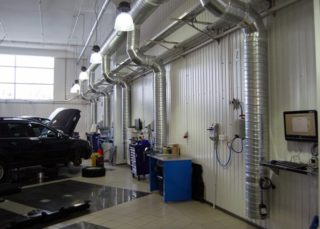
The balance of air exchange in the room is necessary for the normal well-being of the people in it. If there are problems with ventilation, there is not enough fresh air and because of this, unpleasant odors accumulate, the humidity level becomes uncomfortable, and mold appears. These signs indicate the need to check the ventilation system.
The reasons are as follows:
- Installed plastic windows. Such structures are characterized by a high degree of tightness, so not enough fresh air penetrates inside, even if there are no problems with exhaust ventilation.
- Clogged or leaking air ducts. As a result, the outflow of air is disturbed, water vapor and odors are not removed, and mold appears.
- Redevelopment made. Significant transformations lead to a change in the initial conditions for calculating ventilation, so the system may work worse or not work at all.
If the check shows that all the elements are functioning properly, the problem is associated with the incorrect design of the ventilation system initially. Violations are manifested by a lack of traction.
Air exchange standards
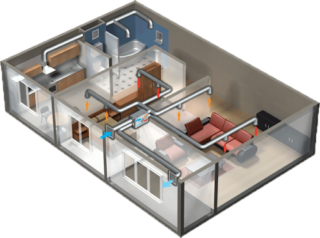
When performing basic calculations for ventilation systems, standards for area, frequency rates and sanitary and hygienic standards are used.
- The ventilation volume norm for the area is 3 m3/ h at 1 m2... The number of permanent residents is not counted.
- According to sanitary and hygienic standards, air exchange is calculated based on the number of residents: 60 m3/ h for each person, and if this is a room where strangers are often, add 20 m for each temporarily present3/ h
- The rates for multiplicity suggest taking into account the purpose of the room. The multiplicity shows how many times all the air in the room should be changed in an hour.
When drawing up the project, one more feature is taken into account: the exhaust and inlet openings are not placed in the same room. It is important that the inflow is carried out through the living rooms: a bedroom, a living room, a nursery, and the hood is located in places of service: a kitchen, a bathroom, a toilet. Due to the observance of this rule, unpleasant odors will not spread into living rooms.
Russian norms are much tougher than European or American ones. In addition, domestic standards take into account the specifics of the climate and architecture.
Checking the air exchange consists in determining the thrust force. It is necessary to bring a match or a strip of paper closer to the hood. The deflection of the flame or sheet towards the hood indicates the normal operation of the system. If there is no noticeable flow movement, the ventilation volume is negligible. This is the result of clogged channels or errors in the project.
Methods for calculating the volume of air in a room
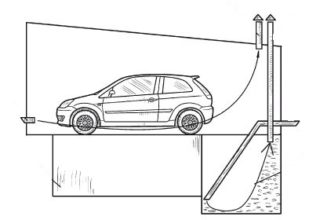
In the calculations of ventilation performance, the parameters that are most important for a particular room are used.
Popular methods for calculating air exchange rates:
- By area: S × 3 m3/ hwhere S - the area of the room for which the supply and exhaust ventilation is calculated, 3m3/ h - the value is constant.
- According to sanitary standards: 60 m3/ h × A + 20 m3/ h × Bwhere A - the number of permanent residents, B - quantitatively temporarily present.
- By air exchange rate: L = N × V. N - the coefficient from the SNiP table is substituted, and V - the volume of the room - the known area or the length and width multiplied by each other multiplied by the height of the ceilings.
To calculate the volume of air in the room that must flow in an hour, more complex computational operations are also performed.
The method for calculating the rate or volume of air exchange by heat surpluses is taken as the basic one when there is a source of high temperature in the room.
Formula for calculating air volume: L = 3.6 × Qout/ (ρ × c × (toud–Tetc)) (m3/hour)where:
- Qout - heat released in W;
- ρ - air density in kg / m3;
- from - mass heat capacity of air;
- toud - temperature of the exhaust air in ° С;
- tetc - temperature of the supplied air, ° С.

To calculate moisture release, the formula is used: L = W / (ρ (dyd–Detc) (m3/hour)where:
- W - moisture release;
- ρ - air density in kg / m3;
- dyd- the amount of moisture in the removed air;
- detc- the amount of moisture in the supply air.
Determination of air exchange by gas emissions is carried out according to the formula: L = K / (Kgdk–Ketc) (m3/hour)where:
- TO - weight amount of emitted gases;
- Kgdk- the upper limit of the normal limit of gas concentration;
- Ketc - concentration of gases in the supply air.
Determination of ventilation parameters based on the calculation of air exchange in terms of hazards is carried out for rooms in which the concentration of harmful substances is increased: tobacco smoke, formaldehyde, gasoline vapors and others. The essence of the method is to determine the volume of fresh air required to reduce the concentration of harmful substances to acceptable values.
The calculation of ventilation performance uses the formulaLn, bp= mro/ (qoz–Qn)where
- mro- the weight of the emitted harmful substances per hour, in mg / h;
- qoz - the maximum permissible concentration of harmful substances in the room, in mg / m3;
- qn - concentration of harmful substances outside, in mg / m3.
From this it is clear that the calculation of air exchange by harmfulness is carried out in the same way as the calculation of gas emissions. The same formula is used.
Air exchange calculations
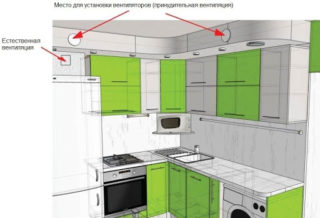
Natural ventilation is provided by air draft. No equipment is used for this. When calculating projects of ventilation systems for residential and industrial premises, a method is often used to determine productivity in terms of rates and sanitary standards.
The preparatory stage of calculating the multiplicity includes compiling a list of all rooms, indicating their volume (V). V is found by multiplying the area by the height of the ceilings. For example:
- living room - 25 m2 (75 m3);
- bedroom - 16 m2 (48 m3);
- children - 12 m2 (36 m3);
- kitchen - 15 m2 (45 m3);
- bathroom - 5 m2 (15 m3);
- toilet - 3 m2 (9 m3);
- corridor - 7 m2 (21 m3).
Then, according to SNiP, the volume of air exchange for each room is calculated, taking into account the multiplicity rates and rounding the values to a multiple of five upwards:
- living room - 25 m3× 3m3/ h = 75 m3;
- bedroom - 48 m3× 1 = 50 m3;
- children - 36 m3× 1 = 40 m3;
- kitchen - 45 m3, not less than 90 m3;
- bathroom - 15 m3, not less than 25 m3;
- toilet - 9 m3, not less than 50 m3.
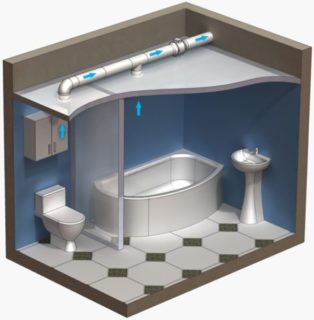
For a corridor, the normal volume of air exchange is calculated by area: 7 m2× 3m3/ h = 21 m3, since in the standards the frequency ratio for this room is not indicated. For the living room, the volume of air exchange in this example is also calculated by area.
Then, the total air exchange of the supply ventilation is calculated, summing up the values obtained for the rooms where the inflow is equipped:
- living room - 75 m3;
- bedroom - 50 m3;
- children - 40 m3.
It turns out 165 m3.
By calculating the exhaust ventilation it turns out:
- kitchen - at least 90 m3;
- bathroom - at least 25 m3;
- toilet - at least 50 m3.
Result 165 m3/ h Comparing the amounts, we find that in this case they are equal, therefore, the basic requirement is met. If the volume of the supplied air turned out to be greater than the volume of the removed air, it was necessary to find the difference between the values and increase the section of the hood in order to equalize the indicators.
The calculation for sanitary standards is performed as follows. For example, there are always 2 people in the bedroom, 2 people in the living room, and 1 person in the nursery. In addition, up to two people can temporarily be present in the living room. The calculations will look like this:
- bedroom - 2 × 60m3/ h = 120 m3/ h;
- living room - 2 × 60 m3/ h + 2 × 20m3/ h = 160 m3/ h;
- for children - 1 × 60 m3/ h = 60 m3/ h
Total inflow: 340 m3/ h
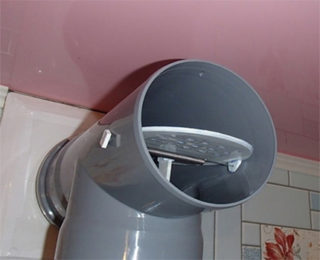
The hood is calculated according to the SNiP norms and increases to the total inflow rate:
- kitchen - 240 m3;
- bathroom - at least 50 m3;
- toilet - at least 50 m3.
The extra volume of air exchange in the hood is distributed between all the "dirty" rooms or only some of them.
The area calculation is performed by multiplying the total area of the house by 3 m3/ h and distribute this volume between the kitchen, bathroom and toilet in the same way.
Selection of the duct cross-section

Ventilation systems are ducted and channelless. In the first case, when calculating ventilation for residential and industrial premises, the cross section of the duct grilles is determined. It is generally accepted that the length and width of the ventilation duct should be in a ratio of 3: 1, while the speed along the main duct is 5 m / s, and on the branches - 3 m / s.
To determine the cross-section of the duct, special diagrams are used. On one side of them there is a scale of ventilation volume, and on the other side - air speed in m / s. Find the intersection by selecting a value of 5 m / s on the air velocity scale and the calculated value of the required supply air volume on the air exchange volume scale. This determines the cross-sectional area for a rectangular duct or the diameter for a round duct. Having calculated the parameters for the main channel, the characteristics for the taps are calculated.
If there are several exhaust ducts, the air exchange volume is preliminarily divided by the number of ducts.
If all the calculations are done correctly, after the installation of the ventilation system, there will always be a comfortable microclimate in an apartment or house. According to the presented formulas and rules, you can design new ventilation or modify the old one.








